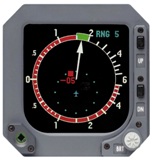Special Use Airspace, RAs, TAs, and close calls
 AOPA recently released a video that contains the audio and video showing the radar on March 21 when on March 21, 2008 a F16 pilot apparently tried to successfully scare the absolute living daylights out of two general aviation pilots flying a Pilatus PC-12 and a Beechcraft Premier. Both aircraft were equipped with a TCAS II system which alerts the pilots and if necessary, provides the pilots with TAs (Traffic Advisories) and if necessary, RAs, or Resolution Advisories. If you have never had the privilege of hearing these sounds, I have provided a sample of what a TA and RA sounds like:
AOPA recently released a video that contains the audio and video showing the radar on March 21 when on March 21, 2008 a F16 pilot apparently tried to successfully scare the absolute living daylights out of two general aviation pilots flying a Pilatus PC-12 and a Beechcraft Premier. Both aircraft were equipped with a TCAS II system which alerts the pilots and if necessary, provides the pilots with TAs (Traffic Advisories) and if necessary, RAs, or Resolution Advisories. If you have never had the privilege of hearing these sounds, I have provided a sample of what a TA and RA sounds like:
Traffic Advisory
[audio:TA.mp3]
Resolution Advisory
[audio:climb.mp3]
So the question is, which one takes precedence? A Resolution advisory or an ATC clearance?
According to FAR 91.123:
When an ATC clearance has been obtained, no pilot in command may deviate from that clearance unless an amended clearance is obtained, an emergency exists, or the deviation is in response to a traffic alert and collision avoidance system resolution advisory.
Another question? Is it ok to fly through a MOA? Let’s take a look at our AIM 3-4-5. It says:
Pilots operating under VFR should exercise extreme caution while flying within a MOA when military activity is being conducted.
Another interesting point about this chapter in the AIM concerning MOAs. Did you know that the military aircraft operating in a MOA can be exempt from at least two rules 1) Aerobatic Flight and 2) Speed *they can operate above 250 knots below 10,000 feet* So, although it might be LEGAL to operate in a MOA, doesn’t sound like a real bright idea.
I uploaded the video to my youtube channel (http://www.youtube.com/askacfi) but you can’t watch it here too. (thanks to AOPA for the video)
Fly Safe (especially in a MOA)


Dave J on Jul 09, 2008
The guys in the Pilatus and Premier were VFR and had visual contact with the F16. In fact, from the audio you can tell that they knew he was forming up on them. My question is, are you supposed to follow an RA even when you have the target visually?
instructor on Jul 09, 2008
My opinion would be that when you have visual contact with the conflicting traffic and you can maintain visual separation without having to deviate from an ATC clearance you should do so. I thought that the Premier pilot in the incident did not have a visual until the fighter was really really close (he says 10 feet). In that case, he should definitely follow the RA.
PlasticPilot on Nov 02, 2008
Do you know as when the FAR 91.123 contains the reference to the RA ? In particular, do you know if it was already so before the Ueberlingen accident ?
Amongst the many factors, was the decision from the Bashkirian crew to follow the ATC clearance and not the RA.
Dan C. on Apr 26, 2009
As a former Marine A-4 driver I think the guys may have over-reacted a bit. Ten feet is not close for military jets. We regularly flew formation at four feet apart and the Blue Angels use 18 inches. On the upside their pax may have a gotten a free thrill.
Shooter on Jul 12, 2014
Dan C. you were a former A-4 driver? Um I think if you had flown an A-4 you would have said “pilot” give me a break!
Also, the F16 pilot was acting like a dipshit. People get authorization to transition through MOA’s all the time.